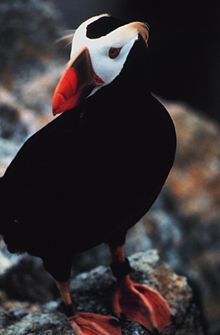Aequorlitornithes
Appearance
| Aequorlitornithes Temporal range:
| |
|---|---|

| |
| Tufted Puffin (Fratercula cirrhata) | |
| Scientific classification | |
| Domain: | Eukaryota |
| Kingdom: | Animalia |
| Phylum: | Chordata |
| Class: | Aves |
| Clade: | Neoaves |
| Clade: | Aequorlitornithes Prum et al., 2015 |
| Clades | |
Aequorlitornithes is a clade of waterbirds recovered in a compressive genomic systematic study using nearly 200 species in 2015. It contains the clades Charadriiformes (waders and shorebirds), Mirandornithes (flamingos and grebes) and Ardeae (Eurypygimorphae and Aequornithes).[1] Previous studies have found different placement for the clades in the tree.[2][3][4]
| Aequorlitornithes |
| ||||||||||||||||||
References
- ^ Prum, R. O. et al. A comprehensive phylogeny of birds (Aves) using targeted next-generation DNA sequencing. Nature (2015). doi:10.1038/nature15697
- ^ Ericson, P. G.P; Anderson, C. L; Britton, T.; Elzanowski, A.; Johansson, U. S; Kallersjo, M.; Ohlson, J. I; Parsons, T. J; Zuccon, D.; Mayr, G. (2006). "Diversification of Neoaves: integration of molecular sequence data and fossils". Biology Letters. 2 (4): 543–547. doi:10.1098/rsbl.2006.0523. PMC 1834003. PMID 17148284.
- ^ Hackett, S. J.; Kimball, R. T.; Reddy, S.; et al. (2008). "A Phylogenomic Study of Birds Reveals Their Evolutionary History" (PDF). Science. 320 (5884): 1763–1768. doi:10.1126/science.1157704. PMID 18583609.
- ^ Jarvis, E.D.; et al. (2014). "Whole-genome analyses resolve early branches in the tree of life of modern birds". Science. 346 (6215): 1320–1331. doi:10.1126/science.1253451. PMID 25504713.
{{cite journal}}: Explicit use of et al. in:|last2=(help)
